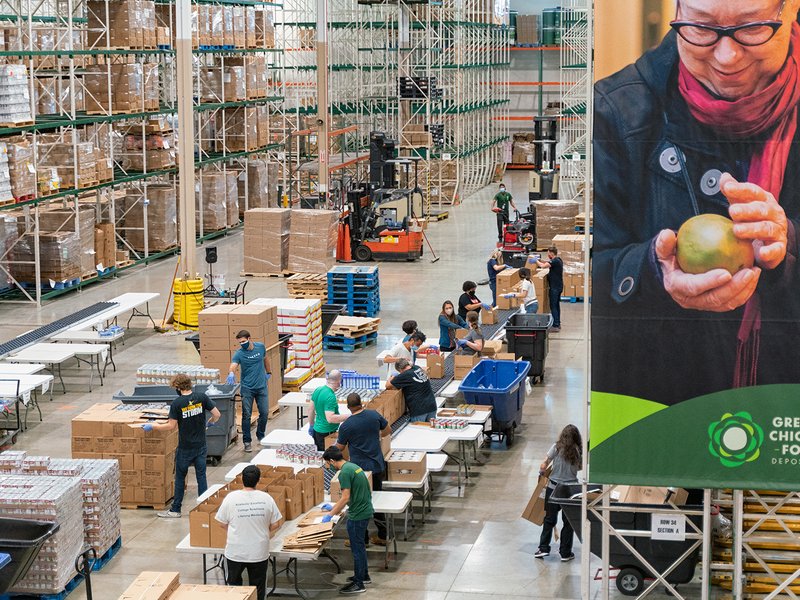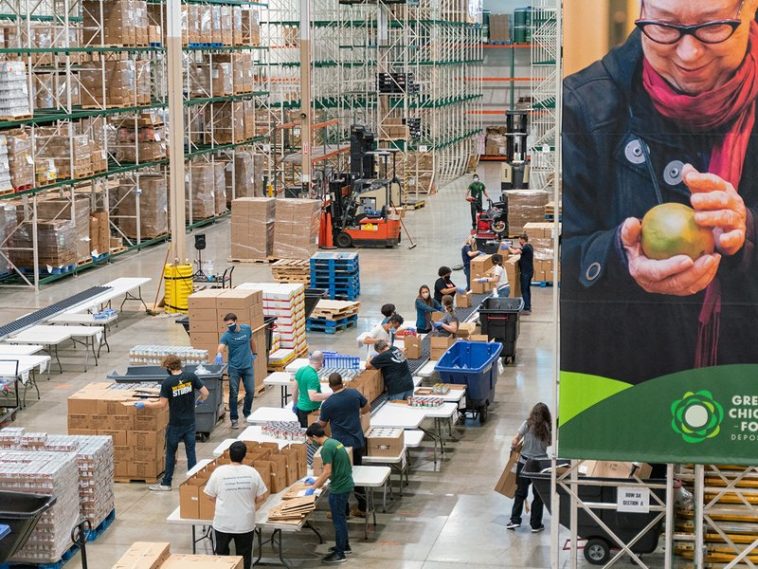COVID-19 puts strain on Chicago-area food banks – Crain’s Chicago Business

COVID-19 spreads hunger along with disease and death, putting immense strain on groups that feed the hungry.
As the pandemic’s economic side effects claimed millions of jobs, food pantries saw a historic surge in demand. The Greater Chicago Food Depository, a food bank that supplies 700 pantries, soup kitchens and shelters in Cook County, says its partners are serving 50 percent more people this year. The story is the same at the Northern Illinois Food Bank, which plays the same role for 900 feeding programs in the collar counties and elsewhere in northeastern Illinois.
“We’ve seen a dramatic increase in need like nothing else we’ve seen during the organization’s 41-year history,” says Greg Trotter, spokesman for the Greater Chicago Food Depository.
Illinois’ experience tracks national trends. Food banks around the country have seen an average 60 percent rise in people needing help, according to Feeding America. The hunger-relief organization estimates that U.S. food banks have only 7 billion of the 17 billion pounds of food they’ll need to feed the hungry this year, a gap that translates into 8 billion meals.
Driving the demand is a convergence of factors arising from COVID-19. Unemployment surged early this year as virus fears and government-mandated mitigation measures forced businesses to cut back or shut down altogether. The jobless rate rose past 14 percent in April before falling to 6.9 percent recently, well above the 3.6 percent level of a year ago. In Illinois, 6.8 percent of the workforce is unemployed, compared with 3.7 percent in October 2019.
Job losses fell hard on relatively low-paid workers in service industries like restaurants, bars and hotels. With fewer resources to cushion a loss of income, many of these people soon found themselves without enough to eat.
“Any reduction in income is going to hit them right away,” says Maeven Sipes, vice president of philanthropy at the Northern Illinois Food Bank.
Remote schooling compounded the need. Families that depended on schools for free or low-cost meals on weekdays suddenly needed more food to feed their children.
Food banks are scrambling to fill the gap. The Greater Chicago Food Depository provided 93 million pounds of food—equal to 77.5 million meals—in the fiscal year ended June 30, a 24 percent jump from the previous year.
“That’s by far the most we’ve ever provided,” Trotter says.
Another side effect of the pandemic has made it harder for food banks to get more food. Consumers stockpiled pastas, soups and other shelf-stable foods in the spring, leaving grocery stores with less excess inventory for food banks. Restaurant closures also reduced the availability of surplus food. To make up the difference, food banks are buying more food in wholesale markets, driving up prices.
“Costs have skyrocketed,” says Trotter. “We’re paying a lot more for food, and we’re buying a lot more food.”
On top of that, COVID thins the ranks of volunteers who pack food boxes and perform other essential tasks at food banks and pantries. Fear of catching the virus keeps many volunteers at home, while social distancing guidelines mean fewer people can work together in packing facilities. Even the work-from-home trend hurts; Sipes says large groups of volunteers from local companies stopped coming to the food bank after their offices closed.
Bad as current conditions are, food banks are bracing for worse. The virus is surging again, triggering lockdowns that could set off another rise in layoffs. Unemployment benefits run out this month for millions of people, likely fueling greater food demand. A federal program that provides emergency food supplies also expires at year-end. Unless Washington passes a new COVID-relief bill that restores these programs, food banks face a grim new year.
“We expect to see things get worse before they get better,” Sipes says.
Both local food banks point to a ray of light amid the gloom: rising donations. The Northern Illinois Food bank raised $9 million between July and October, twice the amount collected during the same period last year. Trotter says his organization saw a similar increase.
So far, contributions have enabled food banks to keep pace with demand. But they’ll need even more to meet both the coming surge and a longer-term rise in food insecurity. So spare a little more for food banks this holiday season. If everyone who has escaped the worst effects of COVID-19 digs a little deeper, no one has to go hungry.
Published at Thu, 03 Dec 2020 23:05:56 +0000





Comments
Loading…